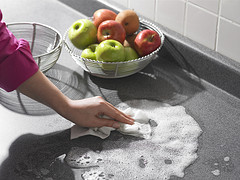For those of us who provide in-home care for seniors, the issue of food safety is a serious one. Seniors are more likely to get sick from harmful bacteria in food compared to other age groups, and when they do become sick, it usually takes them longer to recover. The elderly are more susceptible to foodborne bacteria because as we age, our immune system weakens. Aging also means a drop in the production of stomach acid leading to more bacteria in our intestinal tracts. These factors decrease a senior’s ability to prevent infection and increase the chances of serious complications.
While stories about food contamination felling consumers of fast food burgers, and restaurant chain salad bars create dramatic headlines, foodborne illness is most likely to occur as a result of poor food handling in the home. And this is something that those providing senior care, companion care, nursing home or assisted living support can do something about.
Basics for Handling Food Safely
Since you can’t see, smell or taste harmful bacteria in food it is important that caregivers and home health aides learn the safe steps of food handling, cooking, and storage. The FDA suggests that in every step of food preparation consumers should “follow the four steps of the Food Safe Families campaign to keep food safe:”
- Clean: Wash hands and surfaces often. Bacteria can spread throughout the kitchen and get onto hands, cutting boards, utensils, counter tops and food.
- Separate: Don’t cross-contaminate. Cross-contamination can occur when bacteria are spread from one food to another. This can happen when handling raw meat, poultry, seafood and eggs. Keep these foods and their juices away from other cooked foods.
- Cook: Cook to the right temperature. Food is safely cooked when it reaches a high enough internal temperature to kill bacteria that cause illness.
- Chill: Refrigerate foods promptly. Harmful bacteria can grow in warm or room temperature environments but cold temperatures slow their growth. Do not over-stuff the refrigerator. Cold air must circulate to help keep food safe. The refrigerator should be set at a temperature of 40ºF or below and the freezer should be at 0ºF.
Symptoms of foodborne illness commonly involve the gastrointestinal tract and include abdominal pain, vomiting and diarrhea. You can also get flu-like symptoms, such as fever, headache and body aches. How soon you become ill after you have eaten can vary from 20 minutes to six weeks. Usually, it takes bacteria one to three days to make you feel sick.
The University of Tennessee has produced a downloadable booklet, To Your Health: Food Safety for Seniors that goes into much greater detail about this topic. To view the document, click on Food Safety for Seniors. Food Safety for Older Adults is another great resource produced by the U.S. Department of Agriculture’s Food Safety and Inspection Service and the U.S. Department of Health and Human Services’ Food and Drug Administration.






